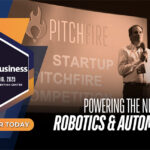Programs like FIRST encourage teamwork and “co-opetition” between teams. Credit: FIRST
This story is Part 1 of a series about how the robotics community can give back to the local community while setting up the next generation for success in science, technology, engineering, and mathematics, or STEM-related careers.
This first story is a personal one. Since 2013, I have mentored a local middle and high school robotics team called ACME Robotics. The team has qualified for Worlds championships three times since its inception. I’ve donated hundreds of hours since 2013 to help shape these young minds and provide them with the opportunity to learn about themselves, develop new skills, and work as a team. In addition, the team members learn how to run a business and design, and build a “product,” in the form of a competition robot.
What I love about competitive robotics programs like FIRST is that they provide a framework for kids to discover and learn about STEM on their own time, while providing the structure of a competition. As a mentor, my role is not to design or build the robot, but rather to teach the skills necessary to build the robot.
The goal of a robotics team is to design and build a competitive robot. Each season, the game rules and challenges are new, but the core requirements of the basic robot remain the same. This parallels the same requirements for a successful business: understanding the market and designing a product that solves a real problem.

FIRST builds its core values around the concept of “gracious professionalism.” Credit: FIRST
STEM competitions lead to career opportunities
On the competition field, teams compete against one another, but they also work with alliance partners that change each match. Team members get to see that there are different solutions to the same problem and that sometimes specializing is better than trying to do everything.
The team members have opportunities to learn from one another and iterate their designs before the next competition. The competition deadlines put time constraints on the design, which subsequently require tradeoffs. These STEM skills are eminently transferable to real life.
FIRST has programs for every age from K-12. The younger kids work with Lego in FIRST Lego League. From there, they can graduate to FIRST Tech Challenge, which uses primarily extruded structures and 3D-printed components.
At the FIRST Robotics Challenge level, high school students design the entire robot in CAD, then machine, weld, and assemble custom parts.
FIRST alumni are highly recruited for both college entry and later for internship and work opportunities. For both college and corporate recruiters, FIRST alumni are often filtered out and reviewed ahead of all other candidates. This opportunity makes STEM and competitive robotics more key enablers of future success than almost any other factor for your child.
Here is the latest FIRST Tech Challenge competition reveal video for the 2025-2026 season:
How can you get involved?
The most important resources in FIRST are mentors and coaches. The second most important resource is funding for the teams. So whether you’re a parent, a technician, an engineer or an entrepreneur, giving back to FIRST is the most important thing you can do to help encourage the next generation of our high-tech workforce.
Starting a team is easy. If your child is interested in robotics, all you need is a garage or a basement, and a set of parts. The kids will do all of the work.
If you are a maker, a technician, or an engineer, then FIRST needs you to be a mentor for a local team. All STEM skills are needed, including project management, programming, electronics, machining, and CAD design.
If you don’t have time on a weekly basis, then volunteer at a tournament. From November through April, there are tournaments every weekend in your region, and the events only happen with the use of volunteers.
Last, but not least, teams need money to operate. Sponsoring a team is the easiest way to help these programs succeed, and to set up this next generation of skilled labor.
Learn more about FIRST at https://www.firstinspires.org/
Learn more about VEX Robotics at

























